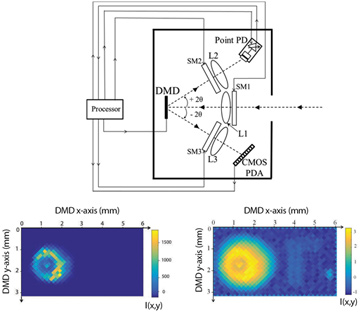 (Top) H-CAOS camera design using a CMOS photodetector array (PDA) as the hybrid element. L1/L2/L3, lenses; SM1/SM2/SM3, “smart” modules for light conditioning; PD, photodetector with amplifier. (Bottom) 82-dB HDR scaled irradiance map of a CAOS-mode acquired image in a linear (left) and logarithmic (right) scale. While the linear scale shows only one target, the logarithmic scale shows that the H-CAOS setup actually picked up all three targets in an HDR scene with extreme contrasts.
(Top) H-CAOS camera design using a CMOS photodetector array (PDA) as the hybrid element. L1/L2/L3, lenses; SM1/SM2/SM3, “smart” modules for light conditioning; PD, photodetector with amplifier. (Bottom) 82-dB HDR scaled irradiance map of a CAOS-mode acquired image in a linear (left) and logarithmic (right) scale. While the linear scale shows only one target, the logarithmic scale shows that the H-CAOS setup actually picked up all three targets in an HDR scene with extreme contrasts.
Recent advances in visible-band CMOS and CCD camera designs have produced high-dynamic-range (HDR) operations (e.g., 80 dB), through electronic control of individual-pixel integration time and pixel electronic-gain control or by acquiring multiple images and computationally reconstructing the scene. Yet achieving even higher dynamic ranges—while maintaining optical spectrum flexibility, minimal inter-pixel crosstalk and the potential for high-speed imaging—remains a challenge. We have developed a camera technology, the coded access optical sensor (CAOS), that works in combination with today’s multi-pixel imaging sensors to pull out previously unseen image features.1
Unlike current CCD or CMOS cameras, the CAOS camera exploits the extreme dynamic range of electronic wireless-style processing. It does this using time–frequency encoding of “agile” pixels in the image space, followed by time–frequency decoding via electronic processing to extract and manipulate the pixel light intensity information.
Essentially, agile pixels in the multi-pixel CAOS image map have specific spatial parameters (such as pixel position, size and shape) as well as specific time–frequency-modulated “telephone number” codes. A single optical antenna/receiver simultaneously detects these pixels, represented as RF-modulated light signals, and, through electronic decoding, rapidly recovers all the deployed agile-pixel light levels. A multi-pixel imaging sensor works with the CAOS camera to provide imaging intelligence that enables space–time electronic programming of agile pixels, for fast extraction of bright, high-contrast targets of interest.
A recently demonstrated, hybrid-element version of the CAOS camera—the H-CAOS or CAOS-CMOS camera—uses a digital micromirror device (DMD) as the CAOS-mode space–time–frequency agile-pixel encoder. The DMD is programmed to direct the incident light to the camera arm with a CMOS photodetector array. Initial scene information is gathered and used to program the DMD in CAOS-mode, thus seeking out the desired pixel HDR regions of the scene. This visible-band camera demonstrated an improvement of three orders of magnitude in camera dynamic range over a commercial CMOS camera when subjected to three test targets that created a HDR scene with extreme brightness as well as extreme contrast (more than 82 dB).
We believe that the CAOS camera platform, used in unison with current multi-pixel sensor camera technology, can enable development of “smart” cameras with extreme dynamic ranges (greater than 140 dB), opening up a world of the yet-unseen across diverse applications.
Researcher
Nabeel A. Riza, University College Cork, Ireland
Reference
1. N. A. Riza et al. Opt. Express 24, 13444 (2016).
